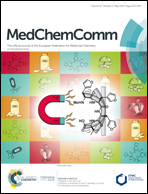3D QSAR-based design and liquid phase combinatorial synthesis of 1,2-disubstituted benzimidazole-5-carboxylic acid and 3-substituted-5H-benzimidazo[1,2-d][1,4]benzodiazepin-6(7H)-one derivatives as anti-mycobacterial agents†
Abstract
Tuberculosis (TB) is one of the world's deadliest infectious diseases, caused by Mycobacterium tuberculosis (Mtb). In the present study, a 3D QSAR study was performed for the design of novel substituted benzimidazole derivatives as anti-mycobacterial agents. The anti-tubercular activity of the designed compounds was predicted using the generated 3D QSAR models. The designed compounds which showed better activity were synthesized as 1,2-disubstituted benzimidazole-5-carboxylic acid derivatives (series 1) and 3-substituted-5H-benzimidazo[1,2-d][1,4]benzodiazepin-6(7H)-one derivatives (series 2) using the liquid phase combinatorial approach using a soluble polymer assisted support (PEG5000). The compounds were characterized by 1H-NMR, 13C-NMR, FTIR and mass spectrometry. HPLC analysis was carried out to evaluate the purity of the compounds. We observed that the synthesised compounds inhibited the growth of intracellular M. tuberculosis H37Rv in a bactericidal manner. The most active compound 16 displayed an MIC value of 0.0975 μM against the Mtb H37Rv strain in liquid cultures. The lead compound was also able to inhibit the growth of intracellular mycobacteria in THP-1 macrophages.
![Graphical abstract: 3D QSAR-based design and liquid phase combinatorial synthesis of 1,2-disubstituted benzimidazole-5-carboxylic acid and 3-substituted-5H-benzimidazo[1,2-d][1,4]benzodiazepin-6(7H)-one derivatives as anti-mycobacterial agents](/en/Image/Get?imageInfo.ImageType=GA&imageInfo.ImageIdentifier.ManuscriptID=C9MD00006B&imageInfo.ImageIdentifier.Year=2019)


 Please wait while we load your content...
Please wait while we load your content...